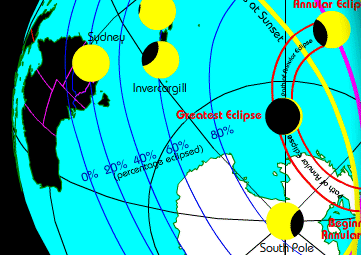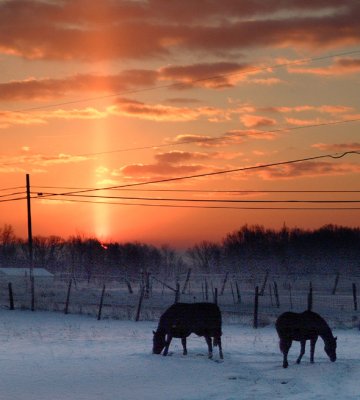| Where's Saturn? Is that a UFO--or the ISS? What's the name of that star? Get the answers from mySKY--a fun new astronomy helper from Meade. | |  |  ASTEROID FLYBY: That was close. Yesterday, newly discovered asteroid 2008 CT1 flew past Earth only 72,000 miles (0.3 lunar distances) away. Had it struck our planet, the 13-meter wide space rock (similar in size to a school bus) would have done little damage, probably exploding in the atmosphere and peppering some lonely stretch of ocean with meteorites. Maybe next time... ASTEROID FLYBY: That was close. Yesterday, newly discovered asteroid 2008 CT1 flew past Earth only 72,000 miles (0.3 lunar distances) away. Had it struck our planet, the 13-meter wide space rock (similar in size to a school bus) would have done little damage, probably exploding in the atmosphere and peppering some lonely stretch of ocean with meteorites. Maybe next time...
SOLAR ECLIPSE: On Thursday, Feb. 7th, the Moon will pass in front of the Sun, producing a solar eclipse over New Zealand, most of Antarctica and parts of Australia: map, timetables. It is not a total eclipse; the Moon will only partially cover the solar disk. Nevertheless, the event promises some beautiful moments. For instance, the partially-eclipsed Sun will dapple the ground with crescent-shaped sunbeams. Observers in New Zealand and Australia should look in the shadows of leafy trees for this lovely phenomenon. On the barren slopes of Antarctica, scientists and explorers can produce the same effect by letting the sun shine through, say, the latticework of a snowshoe. 
Click to view an animated map of the eclipse
It is dangerous to stare directly at a partial eclipse because the exposed portion of the Sun is as blindingly bright as usual. Backyard astronomers with safely-filtered solar telescopes may, however, point their optics at the Sun and watch the mountainous lunar limb glide across the fiery stellar surface. The best views of all are reserved for an remote stretch of the Antarctic where the Moon will pass dead-center in front of the Sun without fully covering it. A thin layer of star will poke out all around the Moon producing a vivid "ring of fire" or annular eclipse. Stay tuned for photos! SUN PILLAR: Breakfasting at dawn? Look up from your feed and behold the sky: 
On Jan. 22nd a bright sun pillar sprung up over the pastures of Southington, Ohio. "It was a cold, overcast morning," says photographer Richard Pirko. Plate-shaped ice crystals fluttering to Earth from high clouds reflected the rays of the rising sun and spread them into a golden column of light. Dawn is a marvelous time to see pillars; all you need is a few clouds, a dash of wintry ice, and a pause between mouthfuls. more images: from Steve Sumner of Auburn, California; from Patrick Cunningham of Farmersville, IL; from Julie Rodriguez Jones near Sparks, Nevada; from Claude Mathieu of Charlevoix, Quebec, Canada.
2008 Aurora Photo Gallery
[Night-sky Cameras] [Aurora Alerts] | 
